[New search]
[Help]
�
2001 No. 264
DISABLED PERSONS
ROAD AND RAILWAY TRANSPORT
Rail Vehicle Accessibility Regulations (Northern Ireland) 2001
| |
Made |
2nd July 2001 | |
| |
Coming into operation |
19th October 2001 | |
ARRANGEMENT OF REGULATIONS
Facilities for disabled persons
Facilities for disabled persons in wheelchairs
The Department for Regional Development[1], in exercise of the powers conferred by section 46(1), (2) and (5) of the Disability Discrimination Act 1995[2] and now vested in it[3] and of every other power enabling it in that behalf and after consultation with such representative organisations as it thought fit in accordance with section 46(11) of the said Act, hereby makes the following Regulations:
Citation and commencement
1.
These Regulations may be cited as the Rail Vehicle Accessibility Regulations (Northern Ireland) 2001 and shall come into force on 19th October 2001.
Interpretation
2.
- (1) In these Regulations -
"class of passenger accommodation" means a type or area of passenger accommodation in a rail vehicle designated for persons paying the fare appropriate to that accommodation;
"contrast" means a contrast in the amount of light, which is reflected by the surfaces of the parts of a regulated rail vehicle or its equipment, which are required by these Regulations to contrast;
"light maintenance services" means services of any of the following descriptions, that is to say -
(a) the refuelling, or the cleaning of the exterior, of locomotives or other rolling stock; and
(b) the carrying out to locomotives or other rolling stock of maintenance work of a kind which is normally carried out at regular intervals of twelve months or less to prepare the locomotives or other rolling stock for service;
"passenger saloon" means that part of the interior of a regulated rail vehicle provided for the accommodation of passengers but does not include a toilet cubicle or a vestibule adjoining an exterior doorway;
"photocell" means a sensing device which operates using a combination of a beam of light, a transmitter and a receiver;
"priority seat" means a seat designated in accordance with regulation 8;
"railway" means a system of transport employing parallel rails which -
(a) provide support and guidance for vehicles carried on flanged wheels; and
(b) form a track which is of a gauge of at least 350 millimetres;
(c) "reference wheelchair" means an occupied wheelchair having the dimensions shown in Diagram A in the Schedule;
"train" means two or more rail vehicles;
"wheelchair-compatible doorway" means a doorway provided in accordance with regulation 18;
"wheelchair-compatible sleeping compartment" means a compartment in a regulated rail vehicle with sleeping accommodation which is provided for a disabled person in a wheelchair in accordance with regulation 16;
"wheelchair space" means a space in a regulated rail vehicle for a disabled person in a wheelchair which is provided in accordance with regulation 15; and
"width" means, when applied to a doorway or passageway, the unobstructed width of that doorway or passageway up to a height of 1,400 millimetres above the door sill or floor, and "wide" shall be construed accordingly.
(2) The Interpretation Act (Northern Ireland 1954[4] shall apply to these Regulations as it applies to an Act of the Northern Ireland Assembly.
Application of the Regulations
3.
- (1) These Regulations apply to rail vehicles used on railways.
(2) A regulated rail vehicle which ceases to comply with these Regulations as a result of equipment failure or damage shall not be required to comply with these Regulations in respect of such failure or damage until the sixth day following the occurrence of such failure or damage.
Facilities for disabled persons
Doors
4.
- (1) Each passenger doorway in the side of a regulated rail vehicle shall be indicated by doors (excluding any window in or control device on the doors) rendered to contrast with the exterior of the vehicle to each side of that doorway.
(2) Each passenger doorway in the side of a regulated rail vehicle shall be fitted with an audible warning device which shall emit warning sounds in accordance with paragraph (3) inside and outside the vehicle in the proximity of each control device for that doorway or, if there is no such control device, adjacent to that doorway.
(3) The audible warning device shall -
(a) emit a distinct sound for a period of not less than 3 seconds commencing when the door becomes openable by a passenger;
(b) if the door is operated by a member of the operator's staff, emit a different distinct sound commencing not less than 3 seconds before the door starts to close.
(4) In this regulation "sound" includes the spoken word.
Door controls
5.
- (1) No control device to enable a passenger to open or close a power-operated door other than a device to which paragraph (3) applies, shall be fitted to a regulated rail vehicle unless -
(a) the centre of the control device is not less than 700 millimetres and not more than 1,200 millimetres vertically above an imaginary horizontal line extended from the door sill of the relevant doorway;
(b) the control device is operable by the palm of the hand exerting a force not exceeding 15 newtons;
(c) the control device or its immediate surround is illuminated continuously whenever it is operable;
(d) the control device contrasts with the surface on which it is mounted; and
(e) the control device is identifiable by touch.
(2) When the power-operated doors are closed by a member of the operator's staff the illumination of each such control device shall cease not less than 3 seconds before the doors start to close.
(3) Subject to paragraph (4) no control device which opens a door automatically as a passenger approaches that door shall be fitted to a regulated rail vehicle unless -
(a) the door starts to open before any part of a passenger reaches a distance of less than 500 millimetres, measured horizontally, from the vertical centre of the line of the door surface;
(b) the door once opened, remains open for a period of not less than 5 seconds before it closes; and
(c) if, after the door starts to close, the edge of the door comes into contact with any part of a passenger the door opens again.
(4) If a control device, to which paragraph (3) applies, incorporates a photocell positioned above the door, the requirement imposed by paragraph (3)(a) will be complied with if the distance from the vertical line of the door is measured horizontally from any single point on that line not more than 300 millimetres above the floor.
Steps
6.
- (1) Steps for use by passengers at any external doorway of a regulated rail vehicle shall comply with the following requirements -
(a) the surface of each tread shall be covered in slip-resistant material;
(b) across the front edge of each tread there shall be a band of colour which shall be not less than 45 millimetres and not more than 50 millimetres deep and shall contrast with the remainder of the tread;
(c) the rear of each step shall be closed by a vertical riser fixed to the rear of the tread and the front edge of the tread above or of the floor of the vehicle;
(d) each step shall be illuminated by a light placed within or immediately adjacent to the step;
(e) each step shall be not more than 200 millimetres high measured vertically from the surface of the tread to an imaginary line extended horizontally from the surface of the next tread or floor of the vehicle and not less than 300 millimetres deep measured from the front of the tread to its rear; and
(f) the surface of each tread shall be not less than 455 millimetres wide.
(2) Paragraph (1)(e) and (f) do not apply if there is not more than one step outside an external doorway.
(3) Subject to paragraph (4), inside a regulated rail vehicle there shall be no step between an external passenger doorway and that part of the passenger saloon to one side of that doorway for as far as and including the vestibule of the next external passenger doorway on the same side of that vehicle or the end of that vehicle if there is no such other doorway.
(4) Paragraph (3) shall not apply to stairs leading to any upper passenger saloon of a regulated rail vehicle.
Floors
7.
The floors of areas used by passengers in a regulated rail vehicle shall comply with the following requirements -
(a) all floors shall be slip-resistant;
(b) the floor of a vestibule adjoining a doorway in the side of a vehicle shall contrast with the adjacent floor in the passenger saloon of that vehicle;
(c) the floor across the width of the doorway between the jambs shall be marked by a strip which shall contrast with the adjoining floor surface, run parallel to the edge of the door sill, be not less than 50 millimetres broad measured from the edge nearer that door sill to the edge further from it and be not more than 100 millimetres from that door sill measured from the edge of that door sill to the edge of the strip further from that door sill.
Seats
8.
- (1) Not less than 10 per cent of the seats in a regulated rail vehicle or 8 seats (whichever is the lesser number) shall be designated by signs complying with paragraph (6) as priority seats for the use of disabled persons.
(2) No priority seat may be capable of being tipped up or folded whilst the regulated rail vehicle is used for carriage.
(3) Each priority seat and the space available to its user shall comply with the specifications shown in Diagram B1 and in Diagram B2, B3 or B4 in the Schedule.
(4) Any armrest fitted to a priority seat shall be movable to the extent required to permit unrestricted access by a disabled person to that seat or any other priority seat to which access may be gained past that seat.
(5) If tables or trays (whether fixed or folding) are fitted for the use of passengers at not less than 10 per cent of the seats (other than priority seats) in a regulated rail vehicle a similar table or tray shall be fitted for the use of persons in each priority seat.
(6) There shall be a sign on or near to a priority seat indicating that disabled persons have priority for the use of that seat.
Interior transparent surfaces
9.
- (1) Subject to paragraph (2) any transparent surface in the interior of a regulated rail vehicle shall -
(a) be separated from an area in which a disabled person can walk, or go in a wheelchair, by a seat, table or other fitting; or
(b) bear a coloured marking which shall not be less than 140 millimetres and not more than 160 millimetres high and extend horizontally across the whole width of the panel at a height of 1,500 millimetres measured vertically from the floor to the bottom edge of that marking; or
(c) be bounded on any side which is not attached to the floor, wall or ceiling of the vehicle by a handrail which shall comply with regulation 10(2).
(2) Where such a surface is a door it shall comply with paragraph (1)(b).
Handrails and handholds
10.
- (1) A handrail shall be fitted in every regulated rail vehicle as close as practicable on either side of the interior of an external doorway extending vertically from a point not more than 700 millimetres above the floor to a point not less than 1,200 millimetres above the floor.
(2) Any handrail in a regulated rail vehicle shall comply with the following requirements -
(a) a handrail shall have a circular cross section with a diameter of not less than 30 millimetres and not more than 40 millimetres;
(b) if a handrail is curved, the radius of the surface of the handrail inside the curve shall not be less than 50 millimetres;
(c) there shall be a clear space of not less than 45 millimetres between any part of the regulated rail vehicle and all parts of the handrail other than its mountings;
(d) a handrail shall have a slip-resistant surface; and
(e) a handrail shall contrast with the parts of the regulated rail vehicle adjacent to that handrail.
(3) Subject to paragraph (4) a handhold shall be fitted to the top of the back of each seat which faces towards an end of a regulated rail vehicle and which is next to a gangway in a passenger saloon and shall comply with the following requirements -
(a) the surface of a handhold (excluding the mountings to the seat) shall be rounded;
(b) a handhold shall contrast with the seat to which the handhold is attached;
(c) a handhold shall have a slip-resistant surface; and
(d) there shall be no gap less than 150 millimetres wide measured in any direction in a handhold or between a handhold and the seat to which it is attached.
(4) Paragraph (3) does not apply to a seat the back of which touches a partition, to a seat the back of which touches the back of another seat which faces in the opposite direction and is fitted with a handhold, or to a seat to which a handrail is attached.
Door handles
11.
A door handle fitted for the use of passengers shall be operable by the exertion of a force not exceeding 15 newtons.
Passenger information
12.
- (1) A regulated rail vehicle shall be fitted with public address systems for audible and visual announcements inside the passenger saloon and for visual announcements on the exterior of the vehicle.
(2) The system for visual announcements on the exterior of the vehicle shall be fitted, if the vehicle is not hauled by a locomotive -
(a) on the front of a single vehicle;
(b) where two or more vehicles are coupled together, on the front of the leading vehicle; or
(c) where five or more vehicles are coupled together, on each side of each vehicle, unless such a system is fitted to the front of the leading vehicle.
(3) The system for visual announcements on the exterior of a vehicle which is hauled by one or more locomotives shall be fitted to each side of each such vehicle, unless such a system is fitted to the front of the leading locomotive and is used such to provide the announcements required by paragraph (4) using letters and numbers which comply with paragraph (7).
(4) Whilst the vehicle is stationary at a station the systems inside the passenger saloon and on the exterior of the vehicle shall be used to announce the destination of the vehicle, or, if the vehicle is following a circular route, the name or number of the route, and, in the case of systems inside the passenger saloon only, to announce the next stop.
(5) Subject to paragraph (6), the systems inside the passenger saloon shall be used -
(a) to announce the next station, at which the vehicle will be stopping, not less than once during the period beginning five minutes before the vehicle is expected by the operator's staff to stop at that station;
(b) to announce any delay exceeding ten minutes to the scheduled timing for that journey;
(c) to announce any diversions from the route shown in the published timetable for that journey; and
(d) to make emergency announcements.
(6) Paragraph (5)(a) does not apply if the timetabled journey time between the stations is less than two minutes.
(7) The first letter of, and numbers used in, announcements on visual systems shall be not less than 70 millimetres high on systems on the front of the vehicle and not less than 35 millimetres high on other systems, and all letters and numbers shall contrast with their background.
(8) A word on a visual system shall not be written in capital letters only.
(9) Visual announcements inside the passenger saloon shall be visible from the majority of passenger seats (including priority seats) in that saloon.
Toilets
13.
If a toilet is fitted in a regulated rail vehicle that vehicle shall comply with the following requirements -
(a) the centre of any door control device on the exterior or the interior of the toilet cubicle shall be not less than 800 millimetres and not more than 1,200 millimetres vertically above the floor;
(b) any door control device, or other equipment inside the toilet cubicle shall be operable by the exertion of a force of not more than 15 newtons;
(c) the seat and any lid on the toilet and any handholds in the toilet cubicle shall be coloured to contrast with the adjacent parts of the toilet cubicle;
(d) the immediate surround of a control device in a toilet cubicle shall be coloured to contrast with that control device and with the part of the toilet cubicle on which it is mounted; and
(e) a control device in a toilet cubicle shall be so constructed as to be identifiable by touch.
Facilities for disabled persons in wheelchairs
Wheelchair spaces
14.
- (1) Subject to paragraph (2) a regulated rail vehicle which does not form part of a train shall contain not less than one wheelchair space.
(2) Subject to paragraph (3), where a train consists of a number of regulated rail vehicles shown in column A there shall be in that train not less than the number of wheelchair spaces shown in column B opposite that number of vehicles:
|
Column A
|
Column B
|
|
2 to 7 vehicles |
2 wheelchair spaces |
|
8 to 11 vehicles |
3 wheelchair spaces |
|
12 or more vehicles |
4 wheelchair spaces |
(3) Where one or more regulated rail vehicles in a train are provided for a different class of passenger accommodation from another regulated rail vehicle in that train there shall be not less than one wheelchair space in each class of passenger accommodation in that train.
Wheelchair space specifications
15.
- (1) A wheelchair space shall comply with the following specifications -
(a) the space shall be not less than 1,300 millimetres long measured in the longitudinal plane of the regulated rail vehicle and not less than 750 millimetres wide measured in the transverse plane of that vehicle;
(b) subject to regulation 17 there shall be no obstruction of the space between the floor and the ceiling of the regulated rail vehicle, other than an overhead luggage rack or an openable window (if fitted);
(c) at one end of the space there shall be a structure or fitting which shall have a minimum width of 700 millimetres and shall be capable of preventing a reference wheelchair, which has been positioned with its back against the structure or fitting, whether or not that movement or tip includes a sideways movement or tip;
(d) no magazine rack or other fitting for the use of other passengers shall be accessible through the space, other than an overhead luggage rack or an openable window (if fitted);
(e) the space shall be fitted with a device, which shall -
(i) enable a disabled person in a wheelchair to communicate with a person who is in a position to take appropriate action in an emergency;
(ii) be placed within reach of a person in a reference wheelchair;
(iii) be operable by the palm of a person's hand; and
(iv) not require a force greater than 30 newtowns for operation; and
(f) a sign conforming to diagram C in the Schedule shall be placed immediately next to, or in, the wheelchair space so as to identify the space as a wheelchair space.
(2)
(a) If a wheelchair space is not needed by a disabled person in a wheelchair, folding or tip-up seats may be used in that space;
(b) when folded or tipped up, those seats shall not project into the space.
Sleeping accommodation
16.
- (1) Subject to paragraph (2) a regulated rail vehicle with sleeping accommodation for passengers shall have not less than one wheelchair-compatible sleeping compartment.
(2) If there is more than one regulated rail vehicle with sleeping accommodation for passengers in a a train, there shall be not less than two wheelchair compatible sleeping compartments in the train.
(3) The doorway into a wheelchair-compatible sleeping compartment and the space beside the bed in such a compartment shall be not less than 850 millimetres wide.
Tables
17.
- (1) If tables or trays (whether fixed or folding) are fitted for the use of passengers at not less than 10 per cent of the seats (excluding priority seats) in a regulated rail vehicle a similar table or tray shall be available for use in any wheelchair space in that vehicle by a disabled person in a wheelchair.
(2) The operator of a regulated rail vehicle shall provide assistance to erect a removable or folding table or tray in a wheelchair space at the request of or on behalf of a disabled person in a wheelchair.
(3) There shall be no obstruction in the space beneath the table-top other than a table-leg positioned so that the unobstructed space beneath the table is not less than 700 millimetres wide when measured at a right angle to the direction in which the wheelchair faces when facing the table.
(4) The lowest point on the underside of the tabletop shall be not less than 720 millimetres vertically above the floor of the regulated rail vehicle.
Wheelchair-compatible doorways
18.
- (1) A regulated rail vehicle in which there is a wheelchair space or wheelchair-compatible sleeping compartment shall be fitted with a wheelchair-compatible doorway on each side of the vehicle in which there is a door for the use of passengers.
(2) The width of the opening of a wheelchair-compatible doorway shall be not less than 850 millimetres.
(3) A sign conforming to Diagram C in the Schedule shall be marked on the exterior of the regulated rail vehicle on not less than one side of the wheelchair-compatible doorway, or on the door, in such a position that it will be visible both before and after the door has opened.
(4) There shall be no step, or slope with a gradient exceeding five per cent measured when the vehicle is on a straight and level track, in or between the wheelchair-compatible doorway and the wheelchair space or wheelchair-compatible sleeping compartment.
(5) The passageway between the wheelchair-compatible doorway and the wheelchair space or wheelchair-compatible sleeping compartment shall be not less than 850 millimetres wide at any point, and shall provide a turning space adjacent to the wheelchair space or sleeping compartment for the disabled person in the reference wheelchair to turn the wheelchair around through one hundred and eighty degrees, which turning space may incorporate the wheelchair space.
Toilets for disabled persons in wheelchairs
19.
- (1) If a regulated rail vehicle or train is equipped with toilets the nearest toilet cubicle to a wheelchair space or wheelchair-compatible sleeping compartment shall comply with the requirements in regulation 13 and with the following requirements -
(a) the exterior of the toilet cubicle door shall be marked with a sign conforming to Diagram C in the Schedule;
(b) the width of the doorway shall be not less than 850 millimetres;
(c) the surface of the toilet seat when lowered shall be not less than 475 millimetres and not more than 485 millimetres vertically above the floor of the toilet cubicle;
(d) the toilet cubicle shall be equipped with facilities to enable a disabled person in a wheelchair to wash and dry his hands without moving from the seat of the toilet;
(e) there shall be sufficient space inside the toilet cubicle for a reference wheelchair to be positioned in front of the toilet and to be positioned at one side of the toilet so that it is possible for a disabled person to move from a reference wheelchair on to the toilet seat from the front or the side of the toilet;
(f) there shall be a hinged handrail beside the toilet, which shall -
(i) be on the same side of the toilet as the space for the reference wheelchair;
(ii) comply with the requirements in paragraph (2)(a), (c), (d) and (e) of regulation 10; and
(iii) comply with the specifications in Diagrams D1 and D2 in the Schedule;
(g) beside the toilet and on the opposite side to the space for the reference wheelchair there shall be a horizontal handrail, which shall comply with the requirements in paragraph (2) of regulation 10;
(h) the toilet cubicle shall be fitted with not less than two devices to enable a disabled person to communicate in an emergency with a person who is in a position to take appropriate action, one to be placed not more than 450 millimetres above the floor measured vertically from the surface of the floor to the top of the control device and the other to be not less than 800 millimetres and not more than 1,200 millimetres above the floor measured vertically to the top of the control; and
(i) each such control shall be operable by the palm of a person's hand exerting a force not greater than 30 newtons.
(2) The passageway between the wheelchair space or wheelchair-compatible sleeping compartment and that toilet cubicle shall be not less than 850 millimetres wide at any point and provide a space adjacent to that toilet cubicle for the disabled person in the reference wheelchair to turn the wheelchair around through one hundred and eighty degrees.
Wheelchair access to on board facilities
20.
There shall be no obstruction to prevent or cause unreasonable difficulty to, a reference wheelchair being manoeuvred to, from, into or out of any wheelchair space, any toilet cubicle complying with regulation 19 or any wheelchair-compatible sleeping compartment in a regulated rail vehicle.
Telephones
21.
If a regulated rail vehicle or train is fitted with telephones for the use of passengers then -
(a) the vehicle or train shall comply with the requirements of paragraph (2), or
(b) the operator shall assist a disabled person in a wheelchair by providing on request a mobile telephone for use in that person's wheelchair space.
(2) The requirements are -
(a) at the telephone nearest to a wheelchair space the top of the telephone equipment shall be not more than 1,400 millimetres vertically above the floor; and
(b) the passageway between the wheelchair space and that telephone shall be not less than 850 millimetres wide at any point and provide a space adjacent to that telephone for the disabled person in the reference wheelchair to turn the wheelchair around through one hundred and eighty degrees.
Internal doorways
22.
- (1) A doorway (other than an external doorway in the side or end of a regulated vehicle) through which a disabled person in a wheelchair must pass to reach a wheelchair space, a wheelchair-compatible sleeping compartment or the nearest toilet or telephone to that space or compartment shall be not less than 85 millimetres wide.
(2) A doorway in the end of a vehicle through which a disabled person in a wheelchair must pass to reach a wheelchair space, a wheelchair-compatible sleeping compartment or the nearest toilet or telephone to that compartment or space shall be not less than 750 millimetres wide.
Boarding devices
23.
- (1) When a wheelchair-compatible doorway in a regulated rail vehicle is open at a platform at a station a boarding device must be fitted between that doorway and the platform if a disabled person in a wheelchair wishes to use that doorway, unless the gap between the edge of the door sill of that doorway and the edge of the platform is not more than 75 millimetres measured horizontally and not more than 50 millimetres measured vertically.
(2) The surface of a boarding device shall be slip-resistant.
(3) No boarding device other than a lift or ramp shall be used.
(4) If a regulated rail vehicle is fitted with a lift it shall comply with the following requirements -
(a) the lift-platform shall be not less than 750 millimetres wide measured parallel to the side of the vehicle and not less than 1,200 millimetres long measured at a right angle to the side of the vehicle;
(b) the lift-platform shall be capable of supporting a weight of not less than 300 kilograms (excluding its own weight);
(c) the surface of the lift-platform shall be marked by a strip of colour, which shall abut the edges of that surface, be not less than 50 millimetres wide and contrast with the remainder of the surface, and the platform shall be coloured on each side with that colour;
(d) the lift-platform shall not travel up or down at a speed in excess of 150 millimetres per second;
(e) the lift-platform shall rest on the surface of the platform of the station when it has been fully lowered;
(f) unless the lift-platform is in its fully lowered position the wheelchair shall be prevented from rolling off the platform by a device with a height of not less than 100 millimetres above the surface of the lift-platform;
(g) the lift-platform shall be fitted with sensors capable of stopping the movement of the lift-platform if it comes into contact with any thing or person whilst it is in motion; and
(h) the lift shall be operable only by persons (other than passengers) who are authorised to operate it by the operator of the vehicle and who shall provide assistance by operating it for disabled persons in wheelchairs.
(5) If the regulated vehicle is fitted with a power-operated ramp -
(a) if the ramp is to be operated by a disabled person in a wheelchair the control button for that ramp shall be adjacent to the wheelchair-compatible doorway and within reach of a person in a reference wheelchair;
(b) the ramp shall be fitted with a sensor along the edge furthest from the vehicle capable of stopping the movement of that ramp if it comes into contact with any thing or person whilst the ramp is in movement;
(c) the ramp shall be incapable of movement in any plane if the surface of the ramp is subjected to a load of 15 kilograms or more;
(d) the operator of the vehicle shall provide assistance to the disabled person in a wheelchair using the ramp unless the gradient of the ramp above the horizontal plane is eight per cent or less; and
(e) the ramp shall not be operable by a passenger unless the vehicle has stopped at a station.
(6) If the regulated rail vehicle is not fitted with a lift or a power-operated ramp, the operator of the vehicle shall provide assistance in deploying and using a separate ramp.
(7) A ramp (whether power-operated or not) shall when in use -
(a) be fixed securely to the regulated rail vehicle;
(b) be not less than 800 millimetres wide and not wider than the opening of the wheelchair-compatible doorway;
(c) have along each side which is not to be crossed by the wheelchair a protective rim standing at least 50 millimetres higher than the surface of the ramp;
(d) be capable of supporting a weight of not less than 300 kilograms (excluding its own weight);
(e) rest its outer edge securely on the surface of the platform of the station; and
(f) be marked on its upper surface by a strip of colour, which shall abut the edge of that surface, shall be not less than 50 millimetres wide and shall contrast with the remainder of that surface and be coloured on each side with that colour.
(8) A boarding device, which is power-operated, shall also be operable manually, and the operator shall provide assistance for such manual operation if the power-operation fails.
(9) A boarding device, which is power-operated, shall not be capable of being deployed unless the vehicle to which it is fitted is stationary.
(10) A boarding device which is carried by a rail vehicle and which is not in use shall be fixed securely to that vehicle so that it does not endanger the safety of persons in that vehicle.
Catering
24.
If catering facilities are provided in a regulated rail vehicle or on a train but there is no passageway for a reference wheelchair from a wheelchair space or a wheelchair-compatible sleeping compartment to those facilities the operator of that vehicle or train shall assist a disabled person in a wheelchair by providing a reasonably equivalent catering service to that person in that space or compartment.
Sealed with the Official Seal of the Department for Regional Development on
2nd July 2001.
L.S.
R. E. Aiken
A Senior Officer of the Department for Regional Development
SCHEDULERegulations 2, 8, 15, 18 and 19
(Note: the diagrams are not in scale)
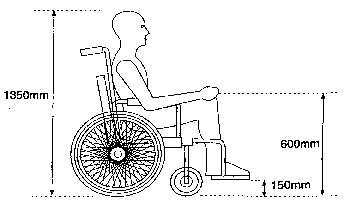
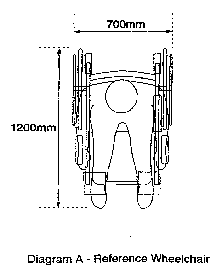
Diagram A - reference wheelchair
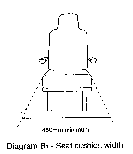
Diagram B1 - Seat cushion width
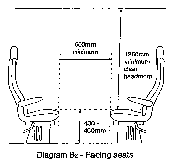
Diagram B2 - Facing seats
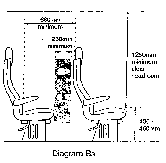
Diagram B3
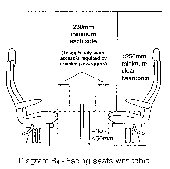
Diagram B4 - Facing seats with table
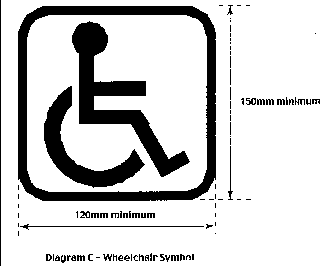
Diagram C - Wheelchair Symbol
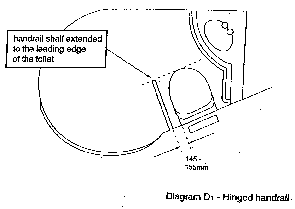
Diagram D1 - Hinged handrail
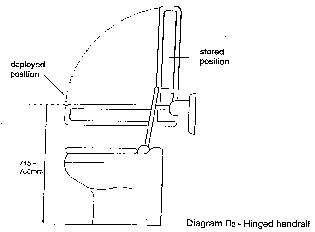
Diagram D2 - Hinged handrail
EXPLANATORY NOTE
(This note is not part of the Regulations.)
These Regulations apply to passenger-carrying vehicles used on railways, (regulated rail vehicles), which are first brought into use, or belong to a class of vehicle first brought into use, after 31st December 1998 (see section 46(6) of the Disability Discrimination Act 1995). They impose requirements for the benefit of disabled persons. The principal features are -
1.
The requirements for the marking of doors, their warning devices and their controls are contained in regulations 4 and 5.
2.
Regulation 6 specifies requirements relating to steps on the exterior and in the interior of vehicles.
3.
Regulation 7 specifies requirements relating to floors.
4.
Regulation 8 specifies the requirements for priority seating for the use of disabled persons.
5.
Regulation 9 contains requirements relating to interior transparent surfaces.
6.
Regulation 10 specifies the requirements for handrails and for handholds fitted to the backs of seats.
7.
Regulation 11 specifies the minimum force needed to operate a door handle.
8.
Regulation 12 specifies the requirements for audible and visual announcements inside and outside the vehicle including their use and contents.
9.
Regulation 13 specifies the requirements for any toilets, which are fitted, to a vehicle.
10.
Regulations 14 to 24 contain additional requirements for the benefit of disabled persons in wheelchairs, including:
(a) the provision of wheelchair spaces, their dimensions and other requirements (regulations 14 and 15);
(b) the provision of wheelchair-compatible sleeping compartments (regulation 16);
(c) the provision of tables in wheelchair spaces, if other passengers have them (regulation 17);
(d) the provision of wheelchair-compatible doorways and passageways to wheelchair spaces and wheelchair-compatible sleeping compartments (regulation 18);
(e) additional requirements for toilets (regulations 19 and 20);
(f) requirements relating to telephones for passengers' use (regulation 21);
(g) minimum internal door width (regulation 22);
(h) the provision of boarding devices, which may be lifts or ramps, and requirements relating to them (regulation 23); and
(i) catering services, if such services are available for other passengers (regulation 24).
These Regulations have been notified to the European Commission pursuant to European Parliament and Council Directive 98/34/EC of 22nd June 1998 laying down a procedure for the provision of information in the field of technical standards and regulations (O.J. No. L204, 21.7.98, p. 37).
Notes:
[1]
S.I. 1999/283 (N.I.) Article 3(1)back
[2]
1995 c. 50; section 46 is modified in its application to Northern Ireland by paragraph 30 of Schedule 8; section 67 is substituted by paragraph 46 of the said Schedule 8; see section 68(1) as substituted by paragraph 47(1) of the said Schedule 8 for the definition of "regulations"back
[3]
S.R. 1999 No. 481 Article 6(d) and Schedule 4 Part IVback
[4]
1954 c. 33 (N.I.)back
ISBN
0 337 93995 0
|
© Crown copyright 2001 |
Prepared
24 July 2001
|
BAILII:
Copyright Policy |
Disclaimers |
Privacy Policy |
Feedback |
Donate to BAILII
URL: https://www.bailii.org/nie/legis/num_reg/2001/20010264.html










